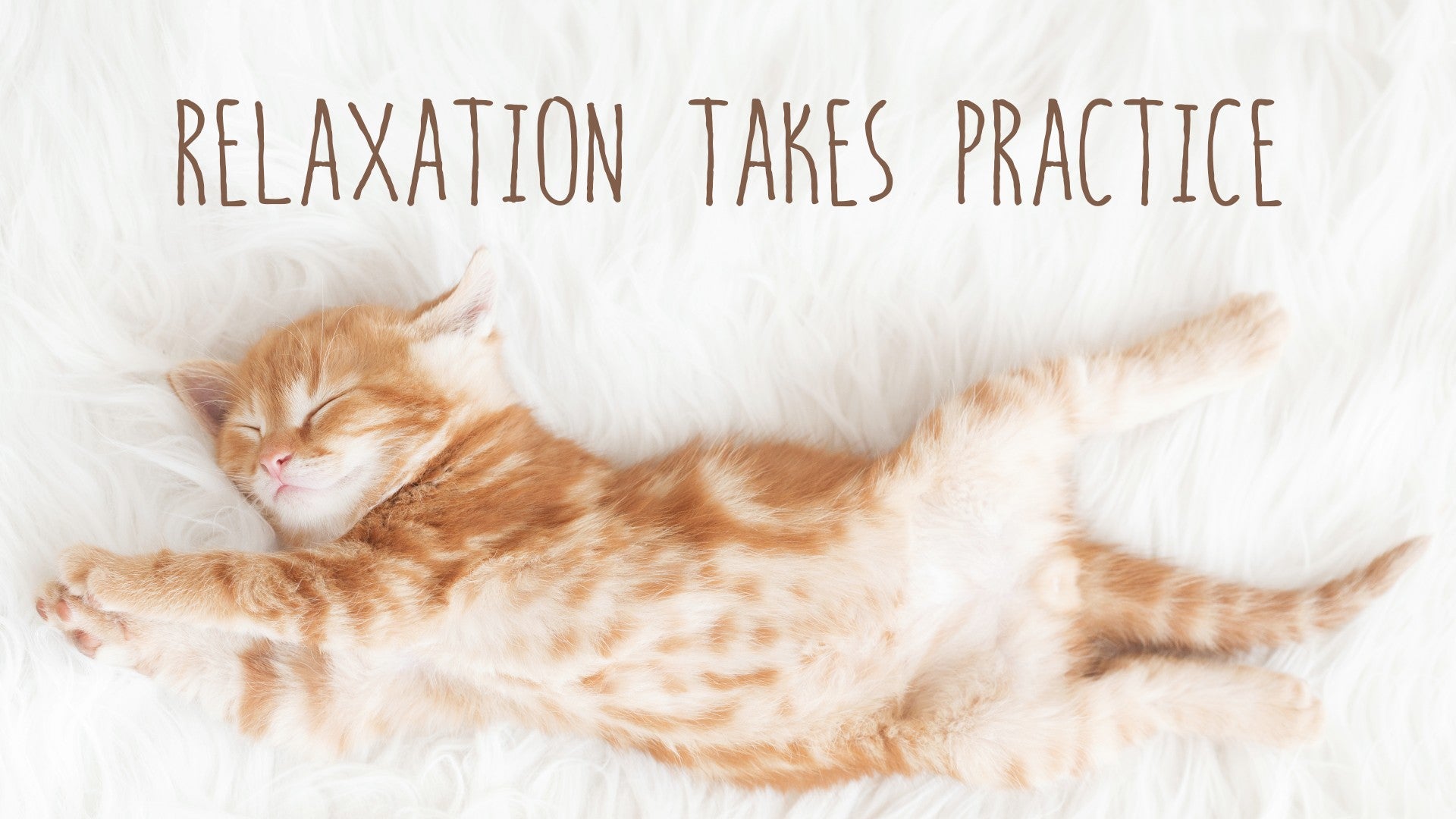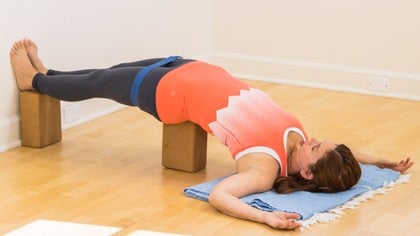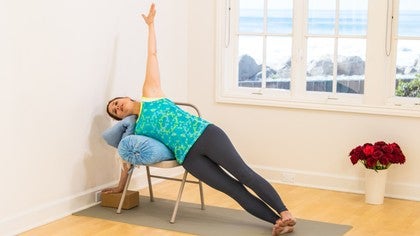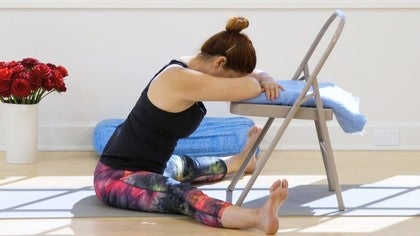Description
About This Video
Transcript
Read Full Transcript
(ocean crashing against the beach) Hi everyone, welcome to Yoga Anytime. I'm happy to introduce to you active restorative yoga today. What you can see is some props situated. We're gonna do about five or six yoga poses, but really, what you should know about this kind of a practice is that we bring a little bit more of the pose to you, that's why we're using the props, and what that does is create little or no effort to be in these poses, so you're not gonna be recruiting a whole lot of effort, just a little bit to hold maybe just a little tension to stay in the pose in a way that doesn't make you collapse, or fall out of it or anything like that. Here are the props that you need for this practice.
You need two chairs, two mats, two blocks, two blankets, two mat pads, one bolster, and one belt. Let's get started. The first one is downward facing dog pose. I have a mat up against the wall with a short edge right up against it. Then I have another chair right up against the wall.
I'm gonna grab the other chair, and turn it around, and I'm gonna take the blanket and fold it up so it makes a pretty good cushion for my hips to go on top of. Now depending on how tall you are, you might wanna put another blanket on top of that to meet the top of your pelvis. Then, I've taken another yoga mat, and just rolled it up and put it in the back. My heels are gonna go on top of that. If you're probably 5'6" and above, you won't need that additional mat, but I'm short, so I need it.
Here's how it works. I'm gonna bring this a little closer to me. I place my heels about hip distance apart, you can always go wider. Straighten through the legs, hinge at the hips, and then bring the top of my pelvis, right underneath the belly, on top of the support, start to slide myself forward, reach out as long as I can, and let the head release down. It's a lot of traction.
We're gonna stay here for a good two minutes. I'm just gonna continue to sort of work my way through the length of the pose by adjusting whenever needed. You can also stretch the arms out in front of you, hold onto the top of the chair, bend through the elbows. I prefer to just just stretch the arms straight out like a classic dog pose, (deep breathing) and then easy inhales and exhales. At any given time, if you want, let your elbows bend, you can fold them.
If you feel like you're getting too much stretch on the shoulders, you can also just rest your head on the top forearm. (deep breathing) Then can you keep your weight back into your legs, firming your thighs just a little bit to keep some stability in the lower body. And then, can you also let your head completely release its full weight like it's just dropping off the top of the spine. (deep breathing) Keep paying attention to the level of sensation that you have, so that it's manageable. (deep breathing) And then notice the breath that you're taking right now.
Listen to it, and finish up with three more full breaths. And then when you complete that third breath, stay on your legs, slide your hands back so they rest underneath the shoulders. Keep the elbows tucked in towards you, press through the palms as you inhale straight through the arms, exhale, walk your feet off the mat if you're standing on it. Bring your had to the top lift of the chair, and stand all the way up. Just rest your arms alongside the body, close the eyes and pause.
(deep breathing) So that pose should really provide a lot of traction in the lower back, and some opening around the shoulders. And now, we're gonna prepare for the next pose. The next pose is a Ushtrasana Camel Pose, and I actually only need one chair for that, so I'm gonna remove this top chair. And I also don't need the mat. I'm gonna place the front legs of the chair right up against the wall, and that's just to give it a little bit of stability.
I'm gonna unfold this blanket 'cause I don't need quite that much height for me. If you're taller, you might. Then, I'm just gonna kneel right in front of the chair. I'll turn myself around, tops of feet on the floor. Sometimes you might like to put a block between your inner ankles, and that helps to keep your legs really steady and your hips pretty compact.
So I'm gonna come right up against it, and where you want the back of the chair to hit is just underneath your shoulder blades. I love this variation; this is great opportunity for someone that has a little tough time getting into this pose, especially creating that arch in the upper mid back and keeping the bend less on the lower back, and more in the mid and upper back. I'm just gonna wrap those arms all the way around the chair. There's other ways to hold this. I like to take my arms and bring them all the way through, and then hold onto this, the side of the chair.
Do the same thing with the other arm. And I just walk my hands down. Firm my lower legs. I get right into that sweet spot. Oh god, it feels great.
Here's where the action comes in. This is the part where you are creating some tension. You're gonna pull the chair, sort of up toward you. And see what that does? It lifts my mid back a little bit more.
Firm the feet. Bring the tailbone slightly forward. And you can either bring your head so that it's right on top of your spine and you're looking forward, or you can lift the chest a little bit more and let it come back. Now, if I do that, I let my shoulders soften a little, and that way that tissue around the upper back or around the neck, it stays soft rather than thick, and it gives me a place for my head to actually release, but you don't need to bring the head back. If you prefer to bring the head straight ahead, then just do that.
And now, just the breath. Just working your way into this. There may be a tendency for the pelvis to fall forward, so keep trying to bring those inner thighs forward, and then that chest up. Every now and then, try to walk your hands down the chair just a little bit more. So let's be quiet for a little bit, about 30 seconds, just breathe together.
Close your eyes. (deep breathing) And then, just be mindful of if you shift your weight too far forward, the chair legs will come off of the floor, and that sort if indicates that chest needs a little more lifting, and the legs need a little bit more firming. Firm the legs, go ahead and firm with me. Draw the shins down, draw those toes back. Walk your hands down the legs of the chair, and let's take our head back if you want, another 30 seconds.
(deep breathing) Relax your jaw. (deep breathing) Listen to the breath that you're taking and finish up with three more. If at any time, you need to bring your head forward again, just do it. (deep breathing) And when you come out of the pose, pull with those hands to lift the chest again, bringing the he'd back into neutral position. Pause a moment here, and then you'll lean your chest forward a bit to release your arms.
Oh gosh, that feels so good. And then, we're actually gonna pause in child's pose, so just scoot yourself forward a little bit. When you feel ready, sit back. Actually, let's just sit here for a couple of seconds just to bring yourself back to neutral. Feel the effects of the pose, and then we'll rest in child's pose a little bit.
And feel free to do any variation you want. If you need to bring your legs a little bit wider, you want to bring your arms in front of you, or alongside you, or you wanna fold your elbows, it doesn't matter. Just work yourself down nice and slowly. Feel the sensations releasing and guiding your way down. (deep breathing) Okay so, let's go ahead and come up.
The next pose we're doing is Sirsasana, or headstand with two chairs, and I need to move the mat around a little bit, so I'm gonna set up for that pose now, and what you'll need is your yoga mat. You'll need two blankets. You'll need two chairs, and then the mat pads. So here's the set-up for the Sirsasana, the headstand. I've taken my mat and brought the long edge now right against the wall, and then the two chairs are facing one another.
These are the mat pads that I was talking about, and basically, you could just take a yoga mat that you're not using so much, cut it up, and make these little pads, but you need them if you're using the blankets. I like the blankets 'cause it's a little more cushion on my shoulders, so this way, the blankets don't slide at all. So I just place them right on top of the chairs like that, and you can see that I've folded this blanket about let's see, it's the typical blanket fold, and then one more time, so it's referred to sometimes as a meditation pad. I'm gonna take the clean, long folded edge and place that right at the edge, and then, I'm gonna fold the other one just like it, and place it just at the edge. So now, here comes the fun part.
I bring these chairs in a little closer. I know it's looking a little scary, but it's not because you want them to be very close to you. The reason is that you want the edge of the chair to come right at the top edge of the upper traps. It's gonna feel great. It's gonna feel like a massage.
So, it's gonna push down, and it's gonna create really great traction for your neck. One of the things I wanna remind you about before we get in is there's a tendency to kind of push your chin forward. Try to keep your head down just a little bit more, and I'll talk you through it as we go, so now you have the set-up, here's what it looks like. You're gonna face your chair, chairs. Come in pretty close.
I just widen my stance. I push one of the chairs out of the way. Draw my head though. Then I look, well I'm not really looking, I'm feeling. I'm feeling to see how close these chairs are.
Are they smashed up against my neck so it doesn't feel like I have any control there at all to move it? Or does it feel really pretty secure? So I just move them so it feels pretty secure, and that's about it right now. You come about two thirds toward the wall, not all the way 'cause you'll be too close, about two thirds. Your hands then come underneath the blankets, and you'll wanna hit those mat pads 'cause you don't want your hands to slide on the blankets.
Keep my elbows in, grip the chair with my fingers, and then walk my feet back. Then I'm gonna walk in, keep my elbows in. Press through my hands, and right now, you'll take an exhale and just let your head release. So we just pause a moment, get yourself in a good space in our head to come up. Then you'll keep pressing those palms, push off the back foot, and come up.
Then once you get up, you'll straighten the legs. Bring the heel bones to the wall, bring the tailbone slightly forward. Here's that dropping of the head. I'm gonna let my head go, and I'm kinda moving around a little bit myself just to get my hair so it's not so caught. You can keep your hips to the wall if you want, or you can draw your hips slightly forward.
Wow, what a massage this is right now. It's awesome. So, now you can let the arms go. As long as you stay in the legs right, you can just let the arms go. And I just pull my elbows to the sides, and my fingers come toward one another.
I'm gonna show you a couple of different arm variations. Here's where we'll stay for the next 30 seconds. So let's be quiet together, and just breathe and feel the effects of this. (deep breathing) So listen to the breath that you're taking right now, and go ahead and take one more. So the next variation of the arms, real easy.
You're just gonna slide the arms through the hole in the chair and let 'em hang. Slide the arms through the other hole in the chair and let 'em hang, so just hanging right out the back into that seat. And you say, "Well, why more the arms?" 'cause when you move the arms, it changes the force a little bit, right? You have a lot more surface now with that chair up against that part of the neck that we're trying to release. If you do a lot of computer work, this is the pose to do.
Let's stay another 30 seconds in this place. Just breathe. (deep breathing) So let's take one more breath together, and then, the last option for your hands is, your arms, is to pull them out, and take one hand to the wall. Just kinda feel your way into that sensation, how that is. Right, if it's a lot and you can be with it, then stay.
If you feel, "Oh, I can do a little more, okay," then start walking your hand closer toward your leg. Whew, there it is. Mmm, it gets right to those knots. And the other walking. So you just kinda figure out, "where can I hold my hands and still be with the sensation in a way that I don't start creating other kinds of sensations, or other kinds of issues that make me want to get out?" Instead, we're gonna stay, and manage what's happening now.
Let's stay these 30 seconds. Feel free to put your arms in any of the variations you were in before you hear the instruction to come out. Let's take one more breath. And then, bring your arms back in the first position, and let's prepare to come out. So stay in your legs. Bring your hands in that very beginning position when you got into the pose.
Your hands come to the seat of the chair, and make sure those heels of the hands are on the mat pads themselves, the fingers wrap around, those elbows stay in, and bring your knees together. The more you press with your hands, and sort of tuck your thighs in towards your chest, and then slowly begin to lower. So I slide my hands back to the top of the chair again and just pause. Then I use one hand to grab a hold of the back rest of the chair, push it out of the way. Then you can slowly bend the knees and set the knees down because now you can get your head out of there.
That's a good thing, right? And then, I'm gonna take a supported child's pose here, so just draw your hips back, fold your arms. Let your head rest on the top forearm, and pause. (deep breathing) Let your thighs and hips be heavy. There's no hurry to get out of this.
We wanna take some time. We've been in the headstand for a few minutes, so take some time for your blood pressure to normalize again. Okay when you feel ready, you can lift your head and push and come up. And we're gonna move into the next pose, and again, I need to set up the pose a little differently, so what you'll be needing to get for this, Setu Bandha Sarvangasana, which is a bridge pose, is you don't need your mat, you just need too blocks, a belt, and a blanket. So let's get ready for that one.
So, here's the set-up for the next pose, Setu Bandha Sarvangasana. It's bridge pose; it's done with two blocks, the blanket, and a belt. And you can see that I've set this block up right up against the wall on it's tallest end. The other one I'm going to set in the tallest end as well. I wanna mention one thing about the setup for the blocks.
You have options obviously not to go that tall. You can go down to the lower level like this, and go down to this lower level. What you want though is you want to make sure that the second block, second from the wall, that this block underneath the tailbone and sacrum is not higher than the block that's at the wall. We wanna keep actually the back bend pretty even so you would never set it up that this is higher and this is lower. This could be higher, right, 'cause your feet would be higher.
That would create less extension on the lumbar, but you get it. Let's move on. I'm gonna take this belt, bring it around me. Why am I using the belt? I'm using the belt because I want it to keep my thighs and legs very compact.
So I bring it up pretty close to my top thighs, give it a good little pull. I've got the blanket set out behind me so that the long, clean edge is going to be underneath my shoulders and head. I scoot myself close to the wall, lower myself down so that comes underneath the shoulders and head, Bring my heel bones on the first block. So, I'm gonna start with a blanket underneath my head, but it might be that once you get your pelvis up, that you feel as though, "oh, I need more height underneath my shoulders and my head," so we'll see how that goes. So press your heel bones into the block to lift your pelvis.
Get to that high end. Place it right at the tailbone and sacrum. And now that I sort of feel this, I would prefer for this blanket to be a little bit more underneath my head. I just lifted my head and pulled the blanket underneath me. Then I'm gonna hold onto the block with my hands, and then I'm gonna slide back until my legs come straight.
I'm gonna slide the blanket a little bit more. It's really easy, I just push my hands on the floor. Lift just my upper back and my head a little, and slide the blanket a little closer underneath me. There we go, and then I like to bring my arms out into this goal post position. Aw, this is good.
Okay, so what you wanna feel is that you don't have your neck totally flat to the floor. You should be able to take one of your hands, and slide it behind your head, behind your neck, and feel that there's, you can get like three fingers easily underneath there. If you can get a lot more than three fingers underneath there like a can of tuna, then you need to get more support underneath you. Okay, now we can let go into the pose. Relax the front of the throat.
I make a little adjustments as I go by, as time goes by, just feeling my way through it. So the little bit of tension that you have is just in the legs, keeping them a little firm, but then the shoulders, totally let them spill out. Let the head be really heavy. You should be able to roll your head from side to side, but don't really necessarily do it. Just kinda feel, "Okay, I have some room to move." And now, let's let go.
Let's take a full minute, just in silence, just being in the pose, breathing and feeling your way through it. So, listen to the breath that you're on, and see if you need to make any other adjustments. Can you relax your shoulders a little more? Can you soften the front of your throat a little bit more? Remember, even though this is considered active restorative poses, which are dynamic poses done with enough supports that you don't have to recruit a whole lot of effort, it's still a restorative pose, so you don't need to try to achieve anything.
You don't need to get the hugest stretch. Just be in the shape in a way that allows you to manage what's happening, and stay in the pose. Watch the breath that you're on now, and take three more. (deep breathing) And when you complete the third breath, you can reach your arms back down to that block underneath your tailbone and sacrum and hold onto it like you did before. Sort of fan your elbows out a little bit, bend one leg at a time, bring the balls of the feet to the floor.
Pause for just a second, and then press into the balls of the feet, and engage the muscles around the buttocks and pelvis, but do not lift the pelvis off the block yet. First, you're just gonna create a little bit of stability there, and then, lift up just enough to bring the block down to the second level, and then lower to the second level, and then, set the feet flat on the floor. You're gonna bring your arms out. You're gonna pause here for about 20 seconds. (deep breathing) Then you're gonna push the feet into the floor again.
Put a little bit of contraction around the back of the pelvis, the lower back muscles, and the buttocks, and then, lift up just enough to put the block on it's lowest level, and lower. Let the arms go free and pause. And then, push the feet into the floor again, contract around the lower back and buttocks just a bit, and then lift up just enough to slide the block all the way out. And then lower slowly. Remove the belt.
Let the feet come flat. I like to slide this blanket out so it's just underneath my head now. Let the arms come out, and totally pause. Let everything melt into the floor. Hold your legs however you prefer.
If you want to pigeon-toe your feet, let your inner knees rest, or stretch your legs further out in front of you, whatever you like. Just feel your way into the sensations that were created because of the back bend. Let the breath and gravity do its thing to release. Okay, so let's slide our hips over to one side, and roll over onto the side of the body and just pause. And then, you can lean the chest into the floor, use your palm to push, and come up to a seated position.
So, we're gonna get the props that we need to set up for the next pose, which is Viparita Karani. That is legs up the wall. It has a little bit more of a back bend variation in it, so we need a couple of things. You're gonna need a bolster, two blocks, a yoga mat that you can fold, so it needs to be thin enough that when you fold it, it's not like super thick, and also a blanket. So, let's set up for that pose now.
So, let's go over the prop set-up for the legs up the wall. You can see that I've taken the thin yoga mat and I folded it in thirds. And it is now right up against the wall, the long edge of it, and then two of the strong yoga blocks, I like the cork blocks 'cause that way they're stable, steady, they're not gonna move around too much. I place them just right at the edge of the wall, and the mat is here because I'm gonna place the bolster on top of it, and I don't want the bolster to slide. So, here's the bolster.
It goes right up against it. And this is sort of a bigger back bend variation. That's why the spacers are here because the pelvis is gonna fall through that space. Then, I grabbed another blanket because I think that you may want one for your head. If you don't, you just push it out of the way.
But to make this more of a back bend, I'm gonna take this blanket, fold it up again, and give myself a little bit more height. Alright, so now we're about ready to go into that somersault, and I've taken the blanket and just sort of pushed it out of the way a little bit, and you should too so that when you get into it and you're all set, you can just slide it right underneath your head. Here we go. The big piece is to make sure that you have your hands right alongside your head, and that the elbows don't splay out to the sides. So, I'm gonna tuck my head right up against that support, tucking the chin, keeping the elbows in, pressing through the palms, pulling my shoulders away from the ears, and then taking those knees up off the floor.
I'm gonna walk in just a little bit, and then as soon as I walk in, I can feel okay, now I can take my chin a little bit more. I push off the back foot, bring the other leg to the wall. Look how slow I'm going. I press through my palms to control the descent. Then my hips slide down.
You wanna feel 'em slide up against that wall, and I'm gonna move these blocks out, give my hips a little bit more room. Reach for that blanket, and then just slowly slide it underneath my head. Tuck my chin just a little, wiggle my hips, give them a little bit more room. Thy can sink down; aw, there we go, into that space. There's always a moment, you know, in yoga poses and everything I guess when we just, you just arrive, and I just feel like I've arrived, and it's good.
Okay, here it is. Now we can close the eyes. Relax the weight of the shoulders. Let that back bend happen. So I sink the weight of the pelvis into gravity.
(deep breathing) Then as I'm feeling my way into this, I'm feeling as though I'd like a little bit more height underneath my head, so I'm just gonna fold that blanket, lift it. Oh, there we go; that's even better. Okay, the interesting thing about using props is that you're gonna feel like you're a princess and the pea here, the prince and the pea, throughout this process because the props provide such support. Your sensibility is just gonna get so refined. You're just gonna really feel all the little, little nooks and crannies of the pose, and your feelings will just stretch out so far, that you'll be able to notice, "Oh, it's just the smallest little bit of height I need, or the smallest little bit of support I need to let go of." (deep breathing) And as you continue to soften into the shape, you'll notice that you will be adjusting your props again.
So what was it? 30 seconds ago that I moved that blanket from a single fold to a double fold. Now another 30 seconds has gone by, and I can feel that it's time to go back. I'm gonna put a little fold underneath my neck. There we go.
So let's stay this next minute and a half quietly together, just breathing and feeling. (deep breathing) Go ahead and take another breath. (deep breathing) And then, let's bend the knees. Let the feet come flat to the wall. And we're just gonna slowly begin to slide back.
Place your hands on the front edge of the support, so you can have a little bit of leverage to pull your weight back. And you can let your lower legs just sort of rest on the bolster and the weight of the shoulders release. Pause here for just a little bit. (deep breathing) And then, we'll slide back again until you're all the way out, and you're just resting the backs of the calves and the ankles. Let the arms come out, let the legs flop, the shoulders release.
You can either keep the blanket, or move it, or unfold it, or fold it, whatever feels right for your body. We're gonna sink right into Shavasana now. You can also slide all the way off the bolster if you prefer. If you tend to hyper extend in those knees, I would slide all the way back, unless you brought the bolster right underneath the knees. Let's drop into this now.
The practice you did was inversion and back bends. It's a perfect set up for Shavasana. (deep breathing) Let's be here together for about eight minutes. This last little minute, let's see if you can let go a little more. Any residual tension, just let it go.
Start to lengthen your inhale, now deepen your exhale. Let some movement stir through your fingers and through your toes, and your wrists and your ankles. When you feel ready to make more of a stretch, then just stretch your arms and legs in a way that feels good. Eventually, let your knees come in towards your chest. Wrap your arms around your legs, and just rock loosely from side to side.
Then eventually, spill over onto the side of body, and slowly push and come up, and just sit in any comfortable seated position. Bring your hands to your chest. So I hope you enjoyed this dynamic restorative yoga practice today. Thanks for joining me. See ya next time.
Namaste.
Relaxation Takes Practice
Comments
You need to be a subscriber to post a comment.
Please Log In or Create an Account to start your free trial.













